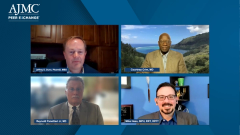
Key Takeaways and Considerations Surrounding COPD Therapies
Medical experts provide their closing thoughts on the chronic obstructive pulmonary disease treatment landscape.
Episodes in this series

Jeffrey D. Dunn, PharmD, MBA: Summarizing everything we’ve talked about, [give] your final thoughts. Courtney, let’s start with you.
Courtney Crim, MD: From the standpoint of managing COPD [chronic obstructive pulmonary disease], we’ve come a long way from where we were 20 or 30 years ago when we looked at it as 2 separate diseases at the end of a spectrum of chronic bronchitis and emphysema. We’ve come to recognize the comorbidities, the extrapulmonary manifestations of the disease, and we’re now addressing that. We have better therapies than we had 20 or 30 years ago through a collaboration with academia, industry, and government agencies, but there’s still a long way to go.
We can’t reverse COPD. As Mike alluded to earlier on, if we can recognize and identify people who are at greater risk of developing COPD, even at an early age, in childhood, those who may have different trajectories as it relates to their decline in FEV1 [forced expiratory volume in 1 second] before they reach a particular stage of COPD, that would significantly advance the disease. It’s being recognized right now. People definitely are thinking about it. We need to develop these types of studies to investigate who’s at risk for it and identify people, even in early childhood, who may be at risk of developing COPD so that we can prevent the downstream effects, which is what we’re talking about today.
Jeffrey D. Dunn, PharmD, MBA: Courtney, thank you. That was a great summary. Rey, what are your final thoughts?
Reynold Panettieri Jr, MD: This was a rich conversation, and we’ve touched on so much. I’ll leave you with 2 comments. We’re on the brink of precision medicine, but we’re not there in COPD. We’re better, but we want to move in that direction. My last comment is that we aren’t treating a disease, we’re treating a person. If we forget about the person whose disease affects them, we start to not do shared decision-making, and we don’t understand how the disease is impacting the individual and their family. The more we build that support system, the better off we are in treating a person and not a disease.
Jeffrey D. Dunn, PharmD, MBA: Rey, thank you. Mike, last word.
Mike Hess, MPH, RRT, RPFT: Tough acts to follow, but I’ll see what I can do. The name of the game is awareness. We need to get more awareness of COPD in the clinical setting and in the general population so that people start to report symptoms earlier and understand their condition a little better. Then we can all start working together to do more research so that we can identify these people even earlier, identify all the risk factors that Courtney talked about, and continue to work together to identify ways that we can improve treatments, communication, and transitions of care. That’s what it’s going to take to get everybody working on the same page.
Jeffrey D. Dunn, PharmD, MBA: You guys were fantastic. Thank you very much. I’d also like to thank our audience for being with us. Hopefully you found this AJMC® Peer Exchange to be useful and informative.
Transcript edited for clarity.
Newsletter
Stay ahead of policy, cost, and value—subscribe to AJMC for expert insights at the intersection of clinical care and health economics.






























































